Above: Alisal High School students visiting Mohammed Mostajo-Radji’s Live Cell Biotechnology Discovery Lab (Photo by Carolyn Lagattuta)
In a classroom at Alisal High School in Salinas, students carefully observe the growth of a cancer tissue cell culture, observing the effect of novel drugs on neuroblastoma, a cancerous tumor.
It’s an extraordinary leap. These students, in a largely agricultural community an hour’s drive from UC Santa Cruz, would not otherwise have access to a biosafety-equipped lab—but through technology developed at UCSC, they are conducting experiments on human cells, remotely. UCSC Genomics Institute researcher and director of the Live Cell Biotechnology Discovery Lab, Mohammed Mostajo-Radji, and a team of scientists are enabling this advanced, project-based learning in classrooms around the globe.
With an internet-connected camera attached to a microscope, students all over the world can access what the equipment in Santa Cruz sees in real time, and can design, hypothesize, and carry out experiments remotely—paving the way for deeper understanding and confidence in science and technology.
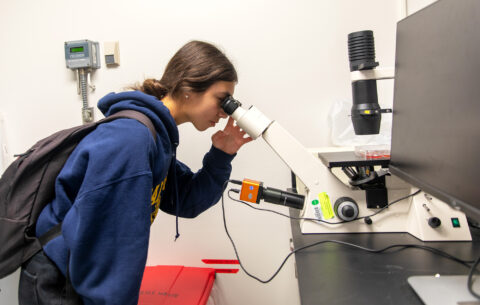
Participating in project-based experiments can pave the way to deeper understanding and confidence in science and technology. (Photo by Carolyn Lagattuta)
This innovative approach reflects the value of open science rooted in the ethos of the Baskin School of Engineering, now celebrating its 25th anniversary. Born in the age of the internet—the school was named in 1997—researchers and students alike are not just pioneers in fields highly relevant to the biggest engineering challenges of the modern world. They also conduct and share their research in such a way that the science is not kept within the walls of academia but benefits the entire planet.
“Open source and open science actively lead to more impactful work,” said Alexander Wolf, dean of the Baskin School of Engineering and a distinguished professor of computer science and engineering. “We know that diverse perspectives and collaborators lead to stronger results. In making it possible for a wider range of people to contribute to research and technical innovation and development, we greatly enhance the quality and significance of the work and bring more voices into a conversation that historically faced structural barriers to participation. Baskin engineers have proved this over the years, and continue to do so as our school grows and our graduates make their impact felt.”
C change
As an example, in the 1980s, it became clear that computer science needed a new programming language to meet the growing demands of rapidly developing technology.
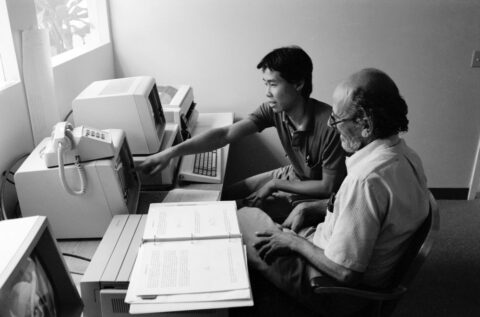
An instructor with a student in the Computer Engineering Center. (Photo by Don Harris, UCSC Photo Services)
Ira Pohl, professor emeritus of computer science, in collaboration with Al Kelley, professor emeritus of mathematics, recognized that the language C, which at the time was only a system implementation language for a few interested experts, could be taught as a language of general use. In a A Book on C, which was widely adapted in classrooms around the world, Pohl made it clear that C was a language that could be used by beginners as a way to learn computer science—and indeed was the dominant language for years and formed the basis for C++, one of today’s most widely used languages.
That success led Pohl to begin offering popular, live televised courses in C, one of the earliest forms of remote online education when the model was in its infancy. Pohl was an early pioneer in massive open online courses (MOOCs) through UCSC, a quickly growing method for open-access remote education. Today, MOOCs are immensely popular and have opened access to high-quality education, in science, technology, engineering, and math (STEM) and other fields, for students around the world—an approach that was essential to sustaining education during the pandemic.
His success continues: In 2022, two of Pohl’s programming-language classes on the popular site Coursera reached more than 200,000 students.
An emerging engineering school
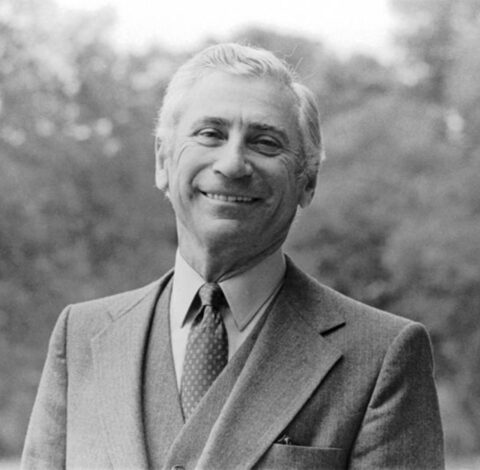
UC Santa Cruz’s engineering school was named after local engineer and philanthropist Jack Baskin. (Photo by Tom Schleich)
While the Baskin School of Engineering was named 25 years ago, it is rooted in the original founding of UC Santa Cruz. In the late 1960s, the Information and Computer Science Department formed in the Natural Sciences Division with three faculty members. As the department grew, faculty and researchers were early leaders in the fields of graphics and artificial intelligence, developing pioneering work in heuristic search algorithms that has become standard in the now-massive field.
By the 1990s, the program expanded to encompass both Computer Science and Computer Engineering Departments, with the former focused on software and computer science applications such as machine learning and the latter focused more on hardware such as circuit design and computer networking.
It was during this time that formal plans came together to create a school of engineering that would be named for local engineer and philanthropist Jack Baskin, whose generosity contributed to the founding. The school’s first dean, Patrick Mantey, professor of electrical and computer engineering, along with the faculty and administration, envisioned a forward-looking school that would veer from conventional programs such as aeronautical or civil engineering to focus on the development of technology relevant to the emerging world of the internet and computing.
“Seeing that we had two dynamic departments, we all realized it would be a huge advantage to have an engineering school,” said Pohl, who joined UCSC in 1970. “But it would be a modern engineering school. Given how close we were to Silicon Valley, it just made a lot of sense to emphasize the kind of engineering and computer science that Silicon Valley needs.”
The human genome: A global resource
Baskin Engineering rapidly became a center of expertise for the fast-growing field of bioinformatics, designing algorithms to address the complexity and volume of biological data. And in 2000, Professor of Computer Science David Haussler, an early expert in the field who went on to found the Biomolecular Engineering Department in 2003, played a crucial role in the open-science project of a lifetime.
The Human Genome Project, an effort funded by the National Institutes of Health to produce the first full sequence of the human genome, was underway with Haussler involved—although originally only in the capacity to apply algorithms to understand the genome once it had already been sequenced.
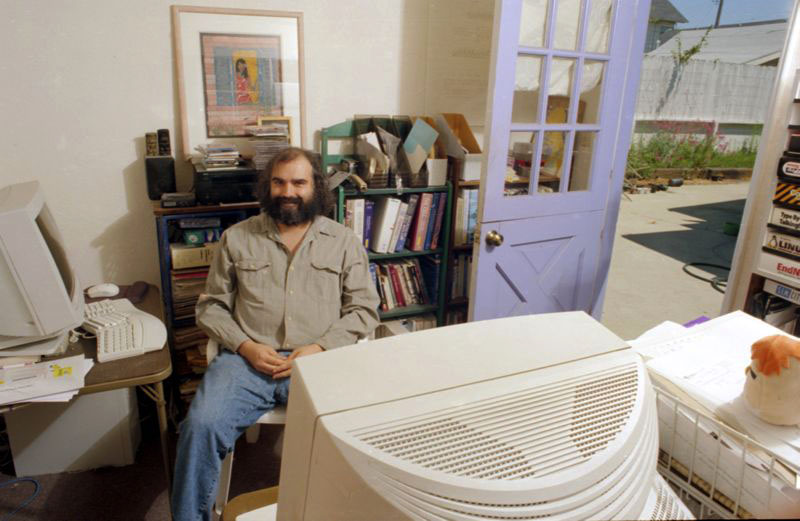
Jim Kent working on the first draft of the human genome in his home office, circa 2000. (Photo by Don Harris, UCSC Photo Services)
However, it became clear that the public project was being outpaced by a private company called Celera, which planned to patent many of the genes and charge for access to the genome once they had completed their first full sequence. The public human genome project was still struggling to assemble a jigsaw puzzle of small DNA segments into a coherent set of human chromosomes. But Haussler and then–graduate student Jim Kent (Kresge ’81, mathematics; M.A. ’86, mathematics; Ph.D. ’02, biology) had their own ideas about how to use computer science methods to solve the genome puzzle, along with a strong belief that it should not be privatized. Celera’s plans kicked them into high gear.
Against all odds and after coding for weeks on end with few breaks, Kent beat out the private team to assemble the first draft of the human genome, sealing the triumph of the public Human Genome Project in a massive scientific feat that was announced by former President Bill Clinton on June 26, 2000. A few weeks later, Haussler and Kent posted the human genome sequence on the Internet on behalf of the public effort, and launched the UCSC Genome Browser so that the human genome could be openly accessed and used by scientists worldwide—for free, forever. Now, an average of 20,000 researchers visit the browser per day, and it serves as an invaluable tool in the evolving understanding of human biology, evolution, and disease.
“We fought for openness,” Haussler said. “That’s the principle that we have stood for from day one.”
The present: A hub for openness
These principles of openness extend to the present day—in the UCSC Genomics Institute, which Haussler later founded, and throughout the entire engineering school. Baskin Engineering is home to the UC system’s only center designated for open-source research, the practice of sharing research products and supporting them with an open-source ecosystem so people can adopt them and collaborate on their improvement, making UC Santa Cruz a hub for this philosophy on a state level.
Led by Carlos Maltzahn, adjunct professor of computer science and engineering, the UCSC Center for Research in Open Source Software (CROSS) was founded in 2015 and serves as an incubator and research center for collaboration among students, industry, and open-source experts. The center was created following a major gift to the school from Professor of Computer Science and Engineering Scott Brandt’s former Ph.D. student Sage Weil, who was extremely successful in open-sourcing the data-storage system, called Ceph, he created for his thesis project.
After selling his company to Red Hat Software, an industry leader in open-source software products, Weil (Ph.D. ’07, computer science) wanted to make it possible for other students at UCSC to follow a trajectory similar to his in bringing their open-source software to market.
Maltzahn said that his team was able to raise $2.6 million in membership fees over six years and gain industry support for the idea that sharing research products using open-source licensing and community management (often called “open-sourcing”) is a powerful alternative path for technology translation, the process of moving research beyond the university, which traditionally uses more exclusive licensing. With the support of a grant from the Alfred P. Sloan Foundation, Maltzahn now also leads an open-source program office (OSPO) for the campus community, one of the first six in the U.S. and one of only three at public universities.
He believes open-sourcing software produced in the context of university research can give students and researchers a powerful advantage within a competitive landscape, as they can receive mentorship from contributors, move faster through the development process, and fit smoothly within existing and emerging industry standards. Meanwhile, companies benefit from avoiding the administrative barriers that come with non–open-source licenses, the quicker pace of development when they maximally leverage existing open-source projects, and the wide network of contributors who can troubleshoot.
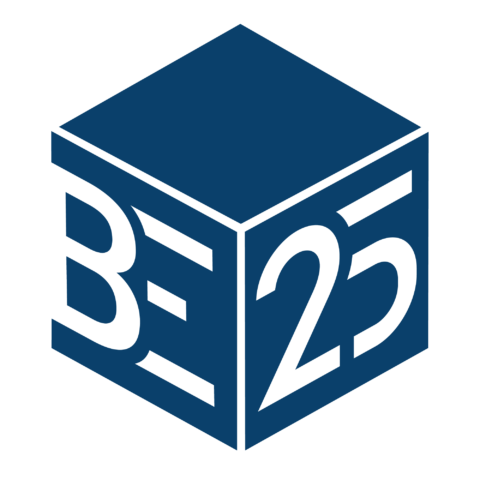
-
- First computer game design program in the UC system, now ranked among the top five in the nation
- First university in the country to offer an M.S. program in Serious Games, which teaches design and development of novel games for high societal impact
- Baskin Engineering researchers ideated and developed nanopore sequencing technology, an affordable tool for reading DNA that has led to major advancements in understanding human disease and evolution.
- Baskin Engineering is currently home to the fifth-largest population of computer science undergraduates in the country. Of the UCSC fall 2022 class, 20% are computer science majors; an additional 10% major in other fields within the Baskin School of Engineering.
Growing awareness of the value of open source
Now, companies, other universities, and even the government are coming to recognize the deep value that open source can bring, as UCSC has for years. This year, the National Science Foundation established the Technology, Innovation and Partnerships (TIP) Directorate, and Congress passed the CHIPS (Creating Helpful Incentives to Produce Semiconductors) and Science Act, providing funding for many new programs that support open-source projects. Part of the mission of TIP is to explore alternative translation paths for technology, including open source.
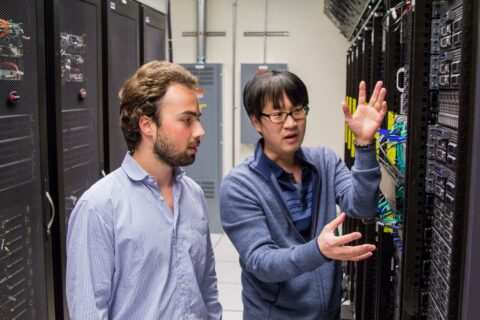
Dongwook Lee, Ph.D., professor and graduate director of applied mathematics (right), and his former student intern Hugues Faller of École Normale Supérieure in Paris (left) talk about modern high-performance computing at the UCSC Data Center. (Photo courtesy Dongwook Lee)
As Baskin Engineering has grown and evolved, open-source software and science remains at the core of much of the work of its engineers. Faculty consistently create consequential software tools—from algorithms to map the distribution of endangered bird species across a continent to bioinformatics software for identifying mutations within cells—that are open source and available to the wider scientific community.
Dongwook Lee, professor of applied mathematics, has been a main code architect for FLASH and Flash-X, open-source codes that can simulate astrophysics and high-energy-density physics research applications and are used by a community of thousands of researchers worldwide. Computational Media postdoctoral scholar Oskar Elek leads PolyPhy, an interdisciplinary open-source software project that models and maps the vast structures of the cosmic web to understand how matter is distributed throughout the universe.
Even in hardware design, an area typically thought of as squarely within the world of patents and licensing, open source is gaining recognition as a way to increase accessibility and performance in designing physical systems—such as a multidepartmental project to create the next generation of cyber-physical transportation systems for which the underlying code will be open source.
The UCSC Genomics Institute continues to host some of the world’s largest open-source repositories for genomic information crucial to human health, such as the SARS-CoV-2 genome browser and phylogenetic tree; the largest-ever assemblage of viral genome sequences; and the BRCA Exchange, the largest, most comprehensive, global public repository for genetic data on the gene that is most strongly correlated with breast and ovarian cancer.
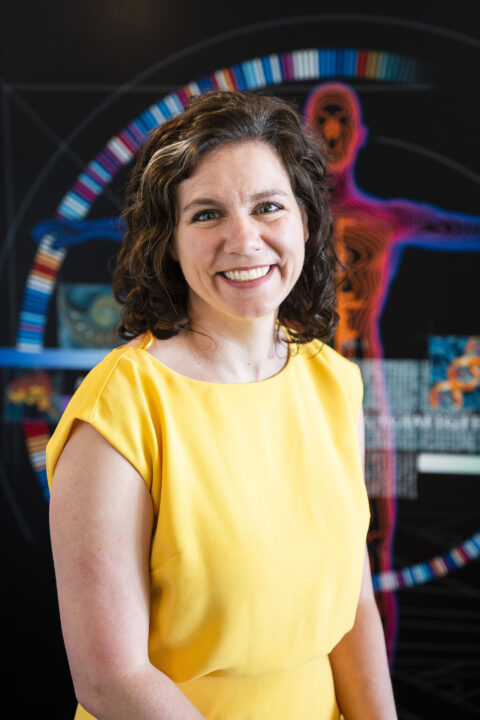
Karen Miga, assistant professor of biomolecular engineering, co-led the team that assembled the first truly complete sequence of a human genome. (Photo by Nick Gonzales)
And this year, Karen Miga, assistant professor of biomolecular engineering, co-led the international Telomere-to-Telomere (T2T) consortium that continued the achievements made two decades ago by Haussler and his team, finally sequencing the areas of the human genome that had been missing from the earlier drafts of the genome and offering deeper understanding of human biology and disease.
Now, along with Benedict Paten, associate professor of biomolecular engineering professor, she is leading an effort to create a human pangenome reference that will include reference genomic sequences representing the world’s diversity and provide access to scientific technology for researchers around the world.
“When we launched the T2T consortium, we did so openly: The data we generated was completely open, and the invitation to participate was also completely open,” Miga said.
As a result, she said, many early-career scientists from diverse backgrounds were major drivers of the works, enriching the project and making it what it is today.
“Now, we are bringing these same values to the pangenome project,” she continued. “We’re striving to make this open-science effort positively impact the participating scientists as well as people worldwide who will benefit from more inclusive biomedical research.”

